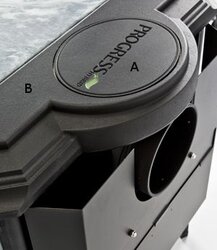So the family and I went to the In-Laws for Thanksgiving and we let the stove go out for the 3 days or so while we were gone.
My plan was to clean the screens and the cat out when we got home before firing up the stove again.
Everything looked great inside, nothing built up on the stove just some tannish/reddish "dust" on the inside and the cat really didn't have much of anything on it at all.
Next I'm cleaning off the underside of the cook top when I notice a long crack in the thing almost from front to back.
I had saved the original stones and heat shield that came with the stove and decided I would just put them back on and call Woodstock to discuss my options about the cook top.
They said that I wasn't the first person that this happened to and they would be glad to replace it.
The thing is that the stove burns completely different without the cook top on it than it did with it.
With the cook top the stove heated up really fast (according to the stove top thermometer) and if I didn't close the flue entirely before around 400 or so degrees the thing would take off on me and be hovering above 600 degrees making me nervous I was going to overfire.
Now without the cook top the stove still comes up to temperature very quickly but I can leave the flue cracked just a little bit with some great secondaries taking place and have the stove top temperature hover around 550 and the stove feels like it's kicking out WAY more heat.
I'm convinced the cook top was super heating and altering the temperature reading I was getting on the stove top.
My burns are MUCH more controllable now and the stove is just radiating huge amounts of heat and I'm really topping out at about 575 degrees on the thermometer...
Discuss!
My plan was to clean the screens and the cat out when we got home before firing up the stove again.
Everything looked great inside, nothing built up on the stove just some tannish/reddish "dust" on the inside and the cat really didn't have much of anything on it at all.
Next I'm cleaning off the underside of the cook top when I notice a long crack in the thing almost from front to back.
I had saved the original stones and heat shield that came with the stove and decided I would just put them back on and call Woodstock to discuss my options about the cook top.
They said that I wasn't the first person that this happened to and they would be glad to replace it.
The thing is that the stove burns completely different without the cook top on it than it did with it.
With the cook top the stove heated up really fast (according to the stove top thermometer) and if I didn't close the flue entirely before around 400 or so degrees the thing would take off on me and be hovering above 600 degrees making me nervous I was going to overfire.
Now without the cook top the stove still comes up to temperature very quickly but I can leave the flue cracked just a little bit with some great secondaries taking place and have the stove top temperature hover around 550 and the stove feels like it's kicking out WAY more heat.
I'm convinced the cook top was super heating and altering the temperature reading I was getting on the stove top.
My burns are MUCH more controllable now and the stove is just radiating huge amounts of heat and I'm really topping out at about 575 degrees on the thermometer...
Discuss!


